[Updated 24/8/22]
Pillows can be a source of major frustration for anyone with neck pain or headaches.
There are so many questions about choosing the ‘correct’ pillow and the ‘correct’ sleeping position. There is also a lot of marketing fluff about pillows and myths about sleeping positions.
This article is a practical approach to the topic.
As a physio who works with patients who have headache and migraine problems, here is a question that is asked at least once a day:
Which is the best pillow?
If you tend to wake in the morning with neck pain, headaches or migraines, a closer look at your pillow is usually warranted.
It is also important to say that your pillow will become less critical if you have a neck problem that is improved with treatment!
This article will answer 13 of the most common questions about pillows and sleeping positions.
I’ll also give my best tips about what you can do to adjust your current pillow to get the best out of it.
Quick Links
- Is it really your pillow to blame?
- Why is it so hard to get the right pillow?
- What is the aim with your pillow?
- What is the best sleeping position?
- Should I bring my pillow to my physio appointment?
- What is the best pillow type?
- Do I need a chiropractic pillow or an orthopaedic pillow?
- Pillow fine tuning tips
- The McKenzie Cervical Roll is a great invention!
- Which pillow do we recommend?
- Pillow FAQs
Is It Really Your Pillow To Blame?
Before we get deep into discussing pillows, there is something that needs to be said.
It is possible that your pillow ISN’T contributing to your neck or headache problem.
We will hear patients say ‘I’ve slept funny’ or ‘I’ve slept wrong’, and it is quickly followed with ‘I must get a new pillow’. But is it really about the pillow?
It isn’t unusual to lay blame on the pillow – it seems like an easy target.
And it’s an attractive thought that buying something could be that easy fix for a problem.
But what else is going on? What has been happening through the day? What is happening in life?
Is the pillow the critical factor?
Because your pillow is one piece of the puzzle.
Is it an important piece of that puzzle, or just one of many small ones?
If there is ‘something’ going on in your neck, treating that problem and improving it can make a huge difference to comfort at night.
That might be achieved through manual therapy, posture changes, ergonomic improvements or simply getting it moving better!
I suspect a lot of people lay blame on their pillow when it may well be the things that they do in the day that are more important.
If you develop headaches or migraines as the day progresses, I feel confident that your pillow isn’t the biggest part of the problem.
However, if you wake with headaches or migraines or neck pain, your pillow deserves some scrutiny!
Why is it so hard to find the right pillow?
When you provide physiotherapy for ongoing headache and migraine problems, it isn’t unusual to speak with patients who rotate through a menu of different pillows.
Surely it shouldn’t be so hard!
Part of the problem with choosing a pillow, the only way you can tell if it suits you is to sleep with that pillow on YOUR bed and over a number of nights.
Another factor that makes it tricky is that the pillow that you buy is kind of … well … fixed.
To buy something that is the correct height for you straight out of the box is quite lucky.
If you have neck pain, or a neck problem that is driving headaches, it seems like there is less margin for error with pillow height. It needs to be just right!
What is the aim with your pillow?
The basic idea is to find a pillow that will support you in a ‘neutral position’ for your head and neck.
What does that mean?
It simply means a position where your head and neck are resting in a comfortable ‘middle of the road’ position.
Not ‘side bent’ or laterally flexed in either direction. Not tilting your head forwards or backwards.
It’s just about letting everything rest in a position where nothing is under any undue pressure.
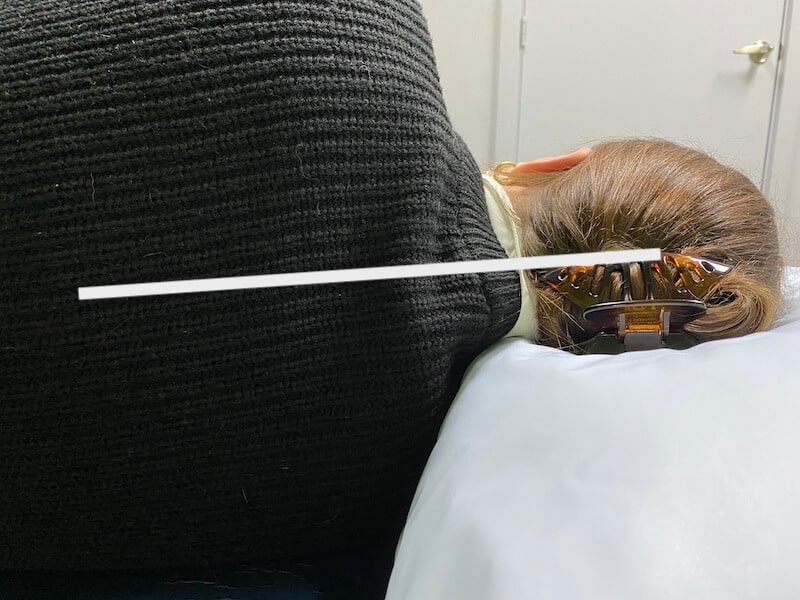
What is the best sleeping position?
In my professional opinion, it doesn’t matter whether someone is a side sleeper or they prefer to be on their back.
Sleeping position isn’t nearly as important as the way that the pillow is set up to support the head and neck for that particular sleeping position.
The ideal pillow height for a side sleeper is different to the ideal height for someone sleeping on their back.
The pillow height usually needs to be higher if you are sleeping on your side.
On your side, the gap created between your shoulder that’s on the bed and your head and neck is greater.
Above all, the most important factor is your comfort and being in a sleeping position that allows you to get a great sleep
If you are someone who has neck pain or stiffness, headaches or migraines that happen on waking, I do suggest avoiding tummy sleeping.
Sleeping on your stomach usually involves being in a degree of neck rotation for long periods. If you are trying to minimise forces on your neck in bed, it makes sense to reduce this.
However, it often isn’t quite as easy as just saying ‘don’t sleep on your tummy’!
It is hard to control what you do in your sleep, and if prone (on your tummy) is a habitual sleeping position, you may well revert to it during the night.
Should I bring my pillow to my physio appointment?
Frankly, taking your pillow to a physio appointment isn’t going to give you much helpful information.
It is impossible to assess whether it is the right height for you based on how it feels on a relatively firm physio treatment table.
This is because they way a pillow feels depends on these four factors:
- the firmness of your mattress
- the firmness your pillow
- your body profile ie the width of your shoulders
- your personal preference
On any other mattress than your own, you won’t get a true idea of how it is going to feel at home.
This creates a dilemma, because if you are spending $400 on a pillow (yes, there are $400 pillows!) you really want to know it is going to work, because you can’t return them!
What is the best pillow type?
The truth is that there isn’t a ‘best pillow’ (despite what the salesperson says!).
So should you get memory foam? Bamboo? Feathers? Latex? There is no definitive answer.
This might sound a bit flippant, but the best pillow material is the one you like the best.
I personally love my memory foam pillow, but some people really dislike the feel of them.
My only comment here is that feather pillows are often quite nice to fluff up and bunch up under your neck, but by the end of the night they do tend to flatten.
Having said that, some people swear by feather pillows, so who am I to judge? It really is whatever works for you.
If you want something that stays the same shape, memory foam is a good material in my opinion.
It comes in different degrees of firmness, so you’d pick the one that suits you the best.
Beware that when it is cold, the foam starts off harder than if it is a warm night.
Do I need a chiropractic pillow or an orthopaedic pillow?
To be honest, I’m not sure what these actually mean!
Perhaps it just means a pillow that is recommended by a chiropractor or an orthopaedic surgeon? Maybe?
So why aren’t there any ‘physio pillows’?
I’m going to give you some ‘physio pillow’ ideas. And as you’ll see, any pillow could be a ‘physio pillow’!
To be clear, if it says ‘chiropractic pillow’ or ‘orthopaedic pillow’ on the label, it doesn’t automatically mean that the pillow is any better than another pillow.
The right pillow is the one that works for you!
Call us on 8356 1000 and let’s help you out!
Pillow fine tuning tips
Before you buy a new pillow, it is worth trying these ideas to see if you can make your current pillow work. This video is a summary of exactly what I tell my patients. It will give you some ideas of things to try.
As you’ll see, there are definitely things that you can alter and experiment with WITHOUT buying a new pillow.
NB: Don’t wait until bedtime to do this!
1. Test the pillow height – can you find the ideal height for you?
The aim is to have a pillow height that feels good and has you resting in more or less a neutral position.
If a pillow is too low or too high, it is going to make you rest in a position that is tilted or sideglided one way or the other.
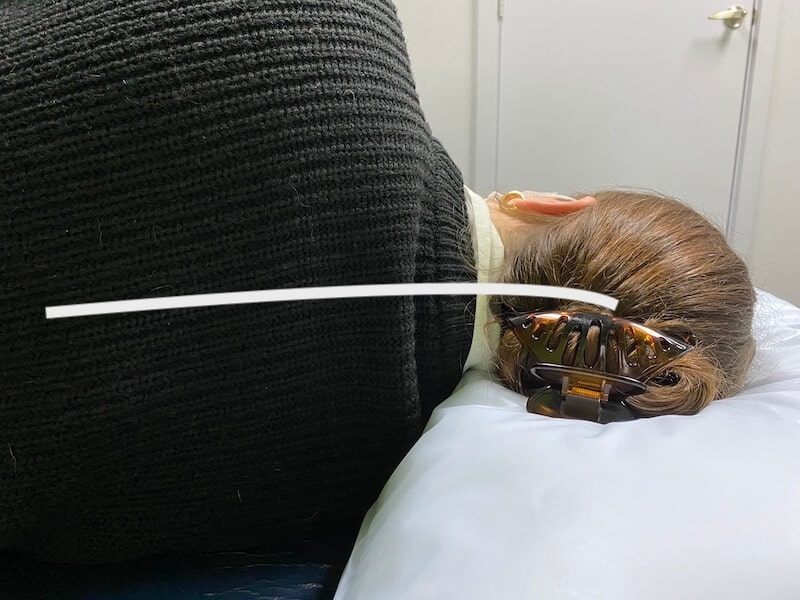
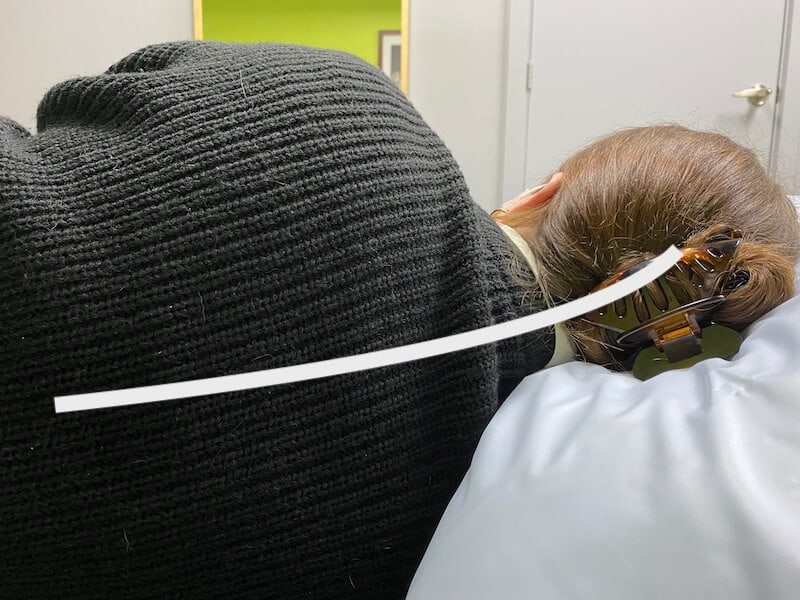
All you need is a few towels. Fold one, put it under your pillow and test it. And add another layer, and another etc until you feel like you have ‘overshot’.
Then remove them one by one until you find a ’sweet spot’ that feels just right for you.
That is going to give you useful information about what the best pillow height is for you.
You could trial this at night as well to confirm it. You may even find that this fixes your problem.
2. Test a neck roll – do you need a bit more contour?
If you take a towel, roll it up into a neck roll like in the video.
Slide it in the front edge of the pillow case, resting on top of the pillow. It will add some contour and some extra neck support.
Experiment with different sizes of rolls to see what feels the best for you.
If you feel like it is good for you, you have three options
-
continue using your own towel cervical roll
-
buy a dedicated cervical roll like the McKenzie cervical roll
-
buy a pillow with more contour
Usually pillows that are contoured have a higher side and a lower side, so you will have a choice about which amount of contour is good for you.
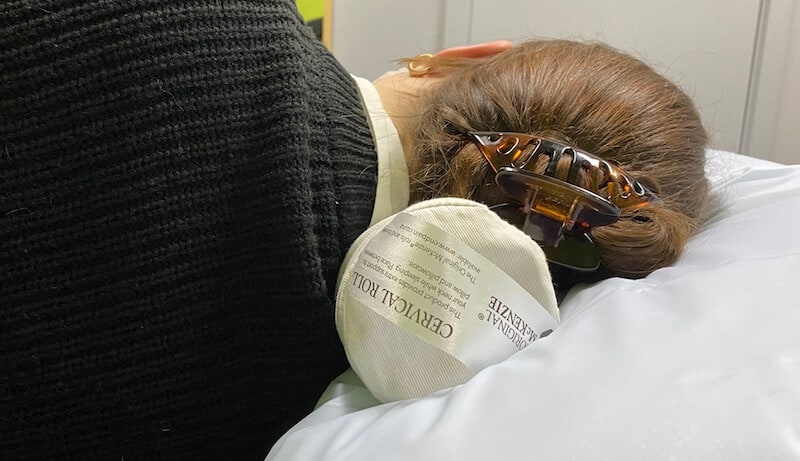
The McKenzie Cervical Roll is a great invention!
The McKenzie Cervical Roll is made from foam that is just the right density for the job. Not too soft that it compresses too easily, but not too firm either.
It’s used inside the pillow case as an extra support under the neck for someone that needs extra to fill in the space.
I know of one person who bought a McKenzie Cervical Roll and uses it to sleep on his back without a pillow. This is the perfect solution for him because he travels a lot and can’t rely on hotel pillows suiting him.
These would be perfect for the person that tries out the towel roll and really likes the extra support but would like something that it made for the job and will hold its shape.
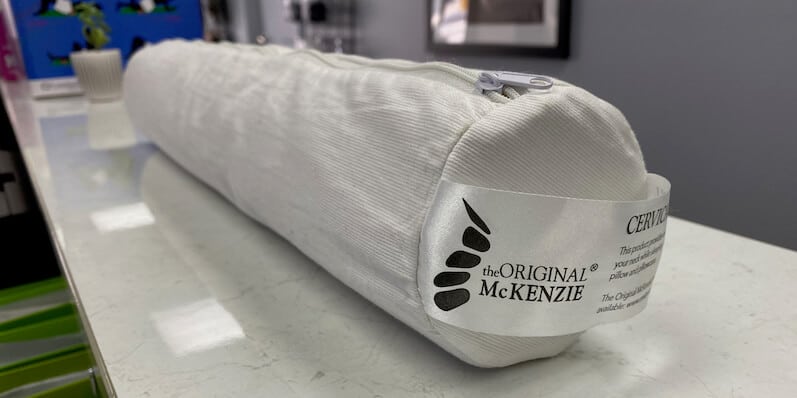
Which pillow do we recommend?
I was always hesitant about stocking pillows in the clinic until we came across an Australian brand of memory foam pillow called Complete Sleeprrr.
The beauty of these is that there is a good amount of playing, adjusting and tweaking you can do to arrive at your best height and shape.
They are quite adjustable for height and depth of the contour, so you aren’t stuck with a pillow that can’t be altered from what comes out of the packaging.
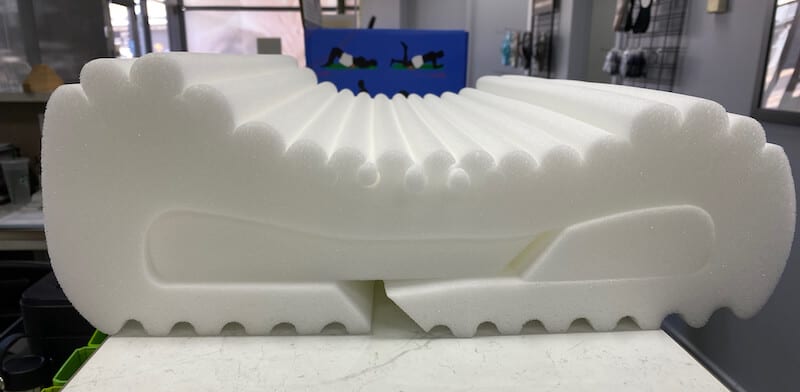
They have two inserts – you can leave them in, take one or both out. These inserts adjust the height and the contour.
There is a high side and a low side so that you can choose which amount of neck and head support suits you.
Also, there are foam noodles that make the softness a little more adjustable too.
The best way to appreciate them is to drop in and have a talk with one of our helpful staff. We can demonstrate how they work and you can try one out.
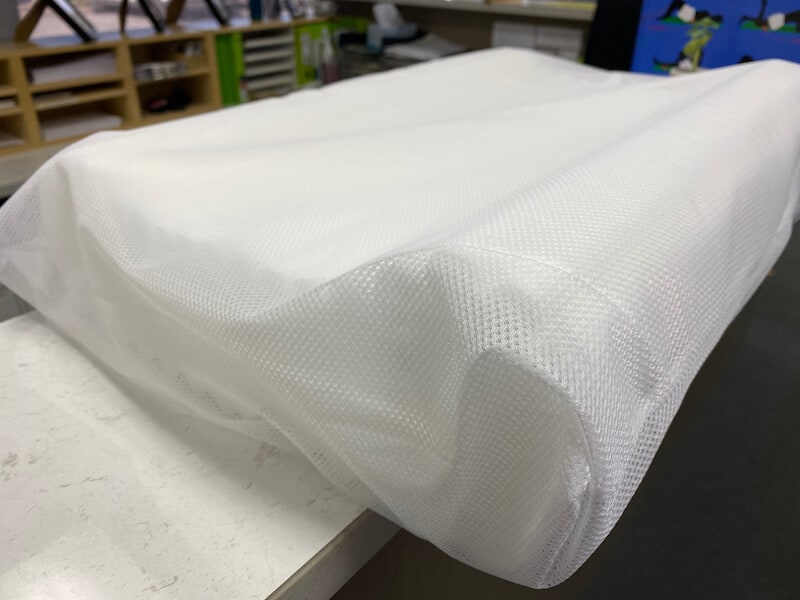
There are four different Complete Sleeprrr adjustable pillows to choose from:
Complete Sleeprrr Gel Infused: This one has extra soft memory foam with a cooling gel technology that is suggested to help keep you cool all year round – our price $120 (RRP $130)
Complete Sleeprrr Original: Soft memory foam which is the most popular option with our customers – our price $110 (RRP $120)
Complete Sleeprrr Plus: This pillow has a firmer density foam, best suited to people with broader shoulders or those who like a firmer surface – our price $110 (RRP $120)
Complete Sleeprrr Deluxe: This one is different – it’s traditional foam with a firm density for those that prefer traditional foam over memory foam – our price $80 (RRP $90)
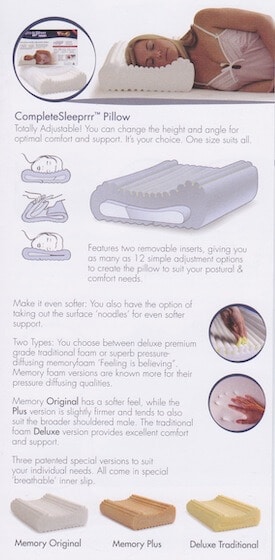
Pillow FAQs
-
What pillow do physiotherapists recommend?
I honestly believe there isn’t a correct material or a best pillow shape for everyone. Whether it has contours or not, whether it is a particular material, it all comes down to the individual’s body shape and personal preference.
I’d recommend a pillow that is adjustable just so that you have options, and if possible, to try out the pillow on a mattress before buying it.
-
What is the best pillow for an elderly person?
The answer is the same regardless of age. The height needs to suit them depending on whether they are a side sleeper or a back sleeper, and it should support their head and neck comfortably.
-
How long does it take for your body to adjust to a new pillow?
This varies from person to person, but you shouldn’t be put off if a new pillow doesn’t feel good to you after the first night or even the first week, especially if it is quite a difference to your old one.
If you persist for a week and it still doesn’t agree with you, it might not be the right pillow height, shape or material for you. -
What are the classic signs of an unsupportive pillow?
Often, a pillow is judged by its age or how flat it is. Better still, it should be judged by whether it supports your body well, and whether it allows you to maintain a good neutral position. And whether it is comfortable!
-
What is the best way to sleep?
There really isn’t a best or worst way to sleep. Some people are side sleepers, some are back sleepers and some are stomach sleepers. The only advice I would give is to avoid sleeping on your stomach if neck pain is a problem for you.
-
What material should my pillow be?
Despite marketing rhetoric, there is no right answer. Everyone has a preference with how they like their pillow to feel, and as long as it is doing a good job of maintaining your neck posture, the type of pillow doesn’t matter.
Other articles that might be of interest:
How can your neck be involved in so many headache and migraine types? – A discussion about how the neck is an underrecognised contributor to all kinds of head pain conditions, not just ‘cervicogenic headache’.
How we help headache and migraine problems – This page will give you an idea of how we help headache and migraine problems using the Watson Headache approach.
Organise A FREE Physio Phone Consult
Get some FREE ADVICE, find out if physiotherapy can help your problem and give you pain relief, and importantly, find out if we are the right physios for you!
Alternatively, you can organise a free 15 minute assessment in person at the clinic.
To Organise a Phone Call with a Physio
- Option one: Click on the ‘Online Bookings’ button at the top of the page, then choose the ‘Free Physio Phone Consult’ option and find a time that suits you.
-
Option two: Call us on
8356 1000 and organise a time for a call back from one of our physios for a discussion with you about your problem.
















